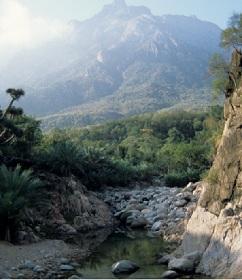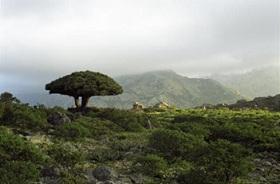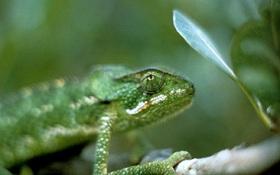Using AI to control energy for indoor agriculture
30 September 2024
Published online 22 March 2011

Public protests in Yemen that began on 27 January have escalated, with security forces now using extreme violence to disperse demonstrators. Snipers killed over 50 people last Friday with shots mostly in the heads and chests. Several generals and soldiers have defected and now side with the protesters. As Western countries warn their citizens against travel to the country and are evacuating those already there, biologists are worried that conservation efforts in one of the region's richest areas for biodiversity, is under threat.
Socotra Archipelago, dubbed the Galápagos of the Indian Ocean, is one such place concerning biologists. It lies about 380 kilometres south of mainland Yemen in the Arabian Sea. The main island, Socotra, is the largest Arabian island. With over 300 unique plant species, a third of the island's flora is endemic, found nowhere else in the world. More than 90% of the reptile species on the island are unique.
"In marine habitats, the extensive coral reefs bordering the island harbour a remarkably high biodiversity and provide an important source for local inhabitants. Both local culture and nature are strongly intertwined and mutually dependent," says Kay van Damme, an ecologist at Ghent University, Belgium, and chairman of Friends of Socotra.
"Islands fascinate biologists because of a disproportionately large number of unique species, occurring on a relatively small area," he explains. The relative isolation of islands makes them ideal for biologists to study speciation and evolution.
Yemen's natural heritage might well be another silent victim of the increased instability.
"Socotra Archipelago is interesting to biologists because it is an old, continental island, an ancient part of South Arabia that separated at the opening of the Gulf of Aden. It contains several plant and animal species no longer found, or no longer common, in Arabia or Africa and went extinct through time because of increased aridity," he adds.
In 2008, Socotra was designated a world natural heritage site by the United Nations Educational, Scientific and Cultural Organization (UNESCO). Its unique and strange selection of flora and fauna has fascinated scientists for decades. The species Dragon's Blood Tree (Dracaena cinnabari) and the genus of strange, freshwater crabs, Socotrapotamon, are examples of some of the island's relicts.
"Conservation in Yemen is centrally-based, depending largely on international support. Therefore changes or instabilities are thought to have indirect and direct effects on biodiversity," says van Damme.
Abdul Karim Nasher, a zoologist at Sana'a University, Yemen, and editor-in-chief of the Yemeni Journal of Science, worries what affect the escalating tension will have on biological research on the island. "Right now most of the [conservation] work on Socatra comes from international agencies and overseas research centres. The Yemenis involved are very few. Because of the unstable situation, many of the colleagues who used to visit us will not be able to come anymore."
"International researchers are being pulled back to their respective countries or requested to stay available for possible evacuation. Advised against all but essential visits by most Western governments, the doors towards Yemen close as embassies assess safety risks," says van Damme.
Researchers that have left Yemen are uncertain when they can return to Yemen or when their respective countries will give clearance again.

Yemen is the poorest Arab state, and one of the least developed countries in the world. The island in particular has few schools and suffers from a high infant mortality rate. For the residents of Socotra, ecotourism became a major source of income in the mid-1990s.
"This was something that the conservation programmes on Socotra have actively encouraged," says Tony Miller, director of the Centre of Middle Eastern Plants at the Royal Botanic Garden in Edinburgh. The present situation could scare tourists off, cutting a major source of income for many people and leading them to look for alternative sources by turning to the natural world. "Over-grazing and unsustainable exploitation of plant resources increases, which in turn leads to environmental degradation — this happens very rapidly in arid and semi-arid tropical and sub-tropical environments."
As the uprising in Yemen continues, the uncertainty is having irreversible effects on biodiversity in Socotra. "Conservation depends on infrastructure, which in turn depends on long-term commitment from international organizations," says van Damme. The weakening of international commitment may break down this infrastructure. Exploitation of terrestrial and marine ecosystems could quickly follow, he warns.
Nasher is worried about the future of research on the island, adding that most scientists have now left the island. However, Ismael Mohamed, a Socotra resident who works as an ecotourist guide, says several foreigners remain oin the island. He stresses that the people on Socotra have not joined the protests taking place in mainland Yemen so there is no violence on the island.

"In times of political upheaval conservation of biodiversity is often considered by donors as something of a luxury. They prefer to fund programmes aimed at things such as 'poverty alleviation' or supporting building 'civil society'," warns Miller.
"To my mind this is a narrow-minded and short-term approach, which ultimately leads to a worsening of the conditions of the lives of people."
Nasher thinks that the large campaigns held in the 1990's to educate people about the importance of biological diversity have reinforced the link between the people and the island and they will protect the delicate balance between development and their natural resources.
As the army defects to side with the protesters continue across Yemen, it seems more likely that the president will step down soon, leading to a change in regime.
"More people are becoming aware that change is needed to fix conditions in Yemen," said Nasher. "But we are worried now that if we get a new regime their relationship with international organizations will be different. We don't know what it will be like which leaves a lot of uncertainty."
Miller points out that there is past evidence of how political crises can have an environmental impact. After the unification of the north and south of Yemen in 1990, the most extensive Juniper woodland in Yemen, which formed the boundary between the north and south regions, was rapidly felled.
Other natural areas of Yemen are also in a precarious position, such as Jebel Bura, which is the last remaining area of woodland on the Yemen escarpment, and the monsoon-affected woodlands of Al-Hauf near the Omani border, says Miller. "The most serious impact is likely to be on an increase in tree cutting for fuel and charcoal and the over-exploitation of certain species."
"As the international community closely follow the developments in Yemen and hope for the well-being of its people, Yemen's natural heritage might well be another silent victim of the increased instability." says van Damme.
doi:10.1038/nmiddleeast.2011.36
Stay connected: